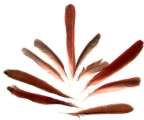 This must have been the year of the cardinals in my backyard. On my frequent trips in my backyard to do garden work or feed the birds, I occasionally came across a cardinal feather. They accumulated over the months and now I have a small collection. I do not keep feathers for long and soon I will put them outside.
This must have been the year of the cardinals in my backyard. On my frequent trips in my backyard to do garden work or feed the birds, I occasionally came across a cardinal feather. They accumulated over the months and now I have a small collection. I do not keep feathers for long and soon I will put them outside.
The male Northern cardinal is an easy bird to recognize and it could be one of the first birds a child learns about. Even its scientific name is easy – Cardinalis cardinalis (it is the same word twice). Here is an information page about cardinals: Cardinals at mbr-pwrc.usgs.gov. At that website, you can also hear the cardinal’s song and its call. I hear the cardinals calling every day and just this evening, I heard cardinals calling all of the other cardinals to come and eat when I walked outside to fill the bird feeders. The more noise I made filling the feeders the faster and louder they called.
Looking the web page linked above, I see that it says the cardinal is 7.75 inches. My bird book says they are 9 inches. I cannot say which one is correct because I have never caught several to measure them.
A word that might be interesting (or not) to your little student is conical. Cardinals have a conical bill. Your little student might associate the word conical with the 3-d geometrical shape cone. Yes, we need to squeeze in some math.
It was a good year for the birds in my backyard because I fed and watered them all summer. That was good for them because we had a dry summer and it was good for me because I enjoy watching the birds between my busy times during the day. I have my feeders right outside my dining room window, so the birds are easy to watch.
Cardinals watch birds too. I noticed them on several occasions watching the other birds eat, not on the bird feeders, but in my vegetable garden. I think the cardinals learned to eat zinnia seeds from the American Goldfinches. I cannot say for certain, perhaps cardinals already knew about zinnia seeds. The funny part comes when the cardinal lands on a zinnia and the zinnia sinks to the ground under the cardinal’s weight.. all the way down to the ground.
When the juvenile cardinals came to the feeder, I have noticed that, in time, they also took up this bird watching. The juvenile cardinals are the cutest things with their one-feathered crest rising up when something caught their eye.
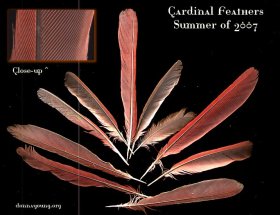 I scanned some of the cardinal feathers that I found throughout this summer and here is an image, click on it to see it larger. I included a section of an enlarged feather so you can see the barbs.
I scanned some of the cardinal feathers that I found throughout this summer and here is an image, click on it to see it larger. I included a section of an enlarged feather so you can see the barbs.
Cardinals like living in brush and bushy places. One winter years ago, five or six cardinals lived in a pile of maple branches that was in my backyard. I asked my husband to wait until spring to clear it so the birds would not have to move. This year they are living our very tall, very bushy Leyland cypress trees. Cardinals are making nests in the tress too. I can hear the little bird chatter when I pass by the trees. I expect them to stay there all winter and I will do my best to continue feeding them.
Just in case your student likes to color, here are a couple of printables, one of a male cardinal and one of a female cardinal.
Image of female cardinal
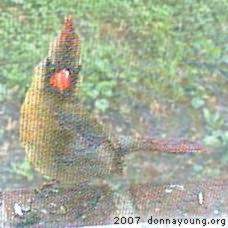
This post was first published on 2007/09/25.
Donna Young
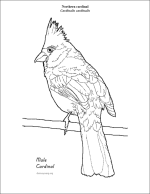
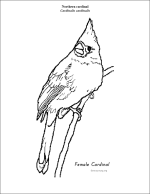


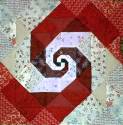

Cardinals are my favorite! They will cheer up the greyest of days. I love your female picture….they have such an expressive face.
Way Cool coloring sheets, Donna!
I love Cardinals too. They are so cheery on a snowy winter day when all you see is white.
How lovely! I think cardinal feathers are the prettiest shade of red. I have a small feather in my collection that the kids got off of a dead cardinal. 😯
Thanks for the coloring pages. The girls will like them.
Thank you for sharing about your cardinals. I don’t know that we get any up here, we may be too far north for such birds.
I think that this winter I’ll try to research what birds do come to my area that I could put our food and such for.
We’re not supposed to put out food for the birds until November and then take them down in either April or May due to bears. I’ve only seen one bear w/in 2 miles of my house but I’m not sure that I want to be the one to draw more in.
Winter time we only see ravens and chickadees. The ravens don’t need us to feed them but they’ll eat what the chickadees drop if they are really hungry.
I realize this post is over a month old, I’m slow. I just wanted to point out that in Texas it is illegal to gather feathers of non-game birds. That may be true in other states, as well. It might be a good idea to point that out to your readers. We just had a Game Warden come talk to our Scout Pack.
It’s not just Texas, it is true for all states. The “Act” does not consider intent and it targets innocents as well as criminals.